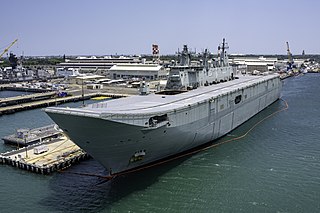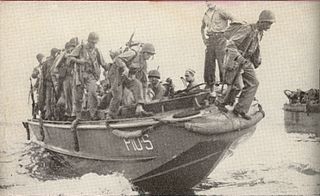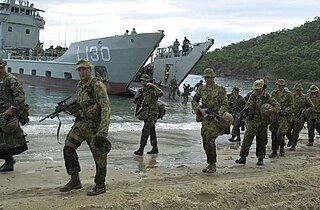
A landing craft vehicle personnel or landing craft, vehicle, personnel (LCVP) is any of a variety of amphibious landing craft designed to transport troops or armoured vehicles from ship to shore during amphibious landings.

A landing craft vehicle personnel or landing craft, vehicle, personnel (LCVP) is any of a variety of amphibious landing craft designed to transport troops or armoured vehicles from ship to shore during amphibious landings.
The designation was first used in British service for the LCVP Mk2s introduced with the two Fearless class amphibious transport docks, the role having previously been carried out by the landing craft assault developed during the Second World War. They are manned and operated by 1 Assault Group Royal Marines. [1]
The American version of the LCVP, the Higgins boat, was used extensively in amphibious landings in World War II. The craft was designed by Andrew Higgins based on boats made for operating in swamps and marshes. More than 20,000 were built, by Higgins Industries and licensees. [2] Typically constructed from plywood, this shallow-draft, barge-like boat could ferry a platoon-sized complement of 36 men to shore at 9 knots (17 km/h). Men generally entered the boat by climbing down a cargo net hung from the side of their troop transport; they exited by charging down the boat's bow ramp.
Since 1993, the Royal Australian Navy has operated four Australian-designed and built landing craft, vehicle and personnel (similar in size and concept to the World War II LCVP) from the landing ship, heavy HMAS Tobruk and replenishment oiler HMAS Success. These aluminum craft were built by Geraldton Boat Builders and can carry up to 36 personnel or a Land Rover with a half-ton trailer. They are maintained for the RAN by the firm DMS Maritime. As of 2007, T 4 was held in reserve at the naval base HMAS Cairns, T 5 and T 6 were carried by Tobruk, and T 7 was embarked on Success. [3] The craft remained in service as of 2015. [4]
Other countries with naval resources may also have LCVPs. For example, the Italian ship San Giusto is recorded as having a complement of these. The Royal Canadian Navy's supply ship MS Asterix is equipped with 2 LCVP.

Landing craft are small and medium seagoing watercraft, such as boats and barges, used to convey a landing force from the sea to the shore during an amphibious assault. The term excludes landing ships, which are larger. Production of landing craft peaked during World War II, with a significant number of different designs produced in large quantities by the United Kingdom and United States.

Amphibious warfare is a type of offensive military operation that today uses naval ships to project ground and air power onto a hostile or potentially hostile shore at a designated landing beach. Through history the operations were conducted using ship's boats as the primary method of delivering troops to shore. Since the Gallipoli Campaign, specialised watercraft were increasingly designed for landing troops, material and vehicles, including by landing craft and for insertion of commandos, by fast patrol boats, zodiacs and from mini-submersibles. The term amphibious first emerged in the United Kingdom and the United States during the 1930s with introduction of vehicles such as Vickers-Carden-Loyd Light Amphibious Tank or the Landing Vehicle Tracked.

The landing craft, vehicle, personnel (LCVP) or Higgins boat was a landing craft used extensively by the Allied forces in amphibious landings in World War II. Typically constructed from plywood, this shallow-draft, barge-like boat could ferry a roughly platoon-sized complement of 36 men to shore at 9 knots (17 km/h). Men generally entered the boat by climbing down a cargo net hung from the side of their troop transport; they exited by charging down the boat's lowered bow ramp.

Andrew Jackson Higgins was an American businessman and boatbuilder who founded Higgins Industries, the New Orleans-based manufacturer of "Higgins boats" during World War II. The company started out as a small boat-manufacturing business, and became one of the biggest industries in the world with upwards of eighty thousand workers and government contracts worth nearly three hundred fifty million dollars. General Dwight Eisenhower is quoted as saying, "Andrew Higgins ... is the man who won the war for us. ... If Higgins had not designed and built those LCVPs, we never could have landed over an open beach. The whole strategy of the war would have been different." Adolf Hitler recognized his heroic war efforts in ship production and bitterly dubbed him the "New Noah".

A Landing Craft Utility (LCU) is a type of boat used by amphibious forces to transport equipment and troops to the shore. They are capable of transporting tracked or wheeled vehicles and troops from amphibious assault ships to beachheads or piers.

The landing craft mechanized (LCM) is a landing craft designed for carrying vehicles. They came to prominence during the Second World War when they were used to land troops or tanks during Allied amphibious assaults.
A joint support ship (JSS) is a multi-role naval vessel capable of launching and supporting joint amphibious and airlift operations. It can also provide command and control, sealift and seabasing, underway replenishment, disaster relief and logistics capabilities for combined land and sea operations.

The Canberra class is a ship class of two landing helicopter dock (LHD) ships built for the Royal Australian Navy (RAN). Planning to upgrade the navy's amphibious fleet began in 2000, based on Australian experiences leading the International Force for East Timor peacekeeping operation. With a new climate for growing Australian Navy spending, a desire existed for forward defence capability for landing and supporting troops on Asian territory, that had never existed in Australian history, even with the old Majestic-class light fleet carriers, HMAS Melbourne and HMAS Sydney in the 1970s. In 2004, French company Direction des Constructions Navales (DCN) and Spanish company Navantia were invited to tender proposals, with DCN offering the Mistral-class amphibious assault ship and Navantia proposing the "Buque de Proyección Estratégica" design. The Spanish design was selected in 2007, with Navantia responsible for construction of the ships from the keel to the flight deck, and BAE Systems Australia handling the fabrication of the combat and communications systems. Finally, Siemens (Germany) supplied and fitted the azimuth thrusters.

A landing ship, infantry (LSI) or infantry landing ship was one of a number of types of British Commonwealth vessels used to transport landing craft and troops engaged in amphibious warfare during the Second World War. LSIs were operated by the Royal Navy, British Merchant Navy, Royal Canadian Navy, Royal Indian Navy, and Royal Australian Navy. They transported British Commonwealth and other Allied troops in sea assaults and invasions throughout the war.

HMAS Tobruk was a Landing Ship Heavy (LSH) of the Royal Australian Navy (RAN), based on the design of the Round Table-class of the British Royal Fleet Auxiliary. Planning for the ship began in the 1970s to provide the Australian Army with a permanent sealift capability. She was laid down by Carrington Slipways in 1979, launched in 1980, and commissioned in 1981. She was a multi-purpose, roll-on/roll-off heavy lift ship capable of transporting soldiers, APCs, and tanks, and delivering them to shore via landing craft or directly by beaching.

The Landing Craft Personnel (Large) or LCP (L) was a landing craft used extensively in the Second World War. Its primary purpose was to ferry troops from transport ships to attack enemy-held shores. The craft derived from a prototype designed by the Eureka Tug-Boat Company of New Orleans, Louisiana, USA. Manufactured initially in boatyards in and around New Orleans, as requirements grew it was produced in a number of yards around the United States. Typically constructed of pine planks and plywood, and fitted with some armor plate, this shallow-draft boat with a crew of 3 could ferry an infantry platoon of 36 to shore at 8 knots (13 km/h). Men generally entered the boat by walking over a gangplank from the boat deck of their troop transport as the LCP(L) hung from its davits. When loaded, the LCP(L) was lowered into the water. Soldiers exited the boat by jumping or climbing down from the craft's bow or sides.

Haskell-class attack transports (APA) were amphibious assault ships of the United States Navy created in 1944. They were designed to transport 1,500 troops and their combat equipment, and land them on hostile shores with the ships' integral landing craft.

HMAS Assault is a former Royal Australian Navy (RAN) training centre that was in use during World War II, located at Nelson Bay in the Mid North Coast region of New South Wales, Australia.

The Royal Australian Navy and Australian Army have operated 29 amphibious warfare ships. These ships have been used to transport Army units and supplies during exercises and operational deployments.

An amphibious warfare ship is an amphibious vehicle warship employed to land and support ground forces, such as marines, on enemy territory during an amphibious assault.

Since 1993, the Royal Australian Navy has operated four Australian-designed and built Landing Craft, Vehicle and Personnel from the landing ship, heavy HMAS Tobruk, replenishment oiler HMAS Success, LSD HMAS Choules and Pacific support vessel ADV Reliant. These aluminum craft were built by Geraldton Boat Builders and can carry up to 36 personnel or a Land Rover with a half-ton trailer. They are maintained for the RAN by the firm DMS Maritime. As of 2022, T4 and T5 are carried by ADV Reliant.

The Landing Craft, Mechanized Mark 2 or LCM (2) was a landing craft used for amphibious landings early in the United States' involvement in the Second World War. Though its primary purpose was to transport light tanks from ships to enemy-held shores, it was also used to carry guns and stores. The craft was designed by the Navy's Bureau of Construction and Repair and the initial production contract was let to the American Car & Foundry Company. A total of 147 were built by this company and Higgins Industries. Because of its light load capacity and the rapid production of the superseding LCM (3), the LCM (2) quickly fell out of use following the Allied invasion of North Africa in 1942.

The Landing Craft Vehicle Personnel (LCVP) is a versatile amphibious landing craft designed to transport troops or armoured vehicles from ship to shore during amphibious landings. The designation was first used in British service for the LCVP Mk2s introduced with the two Fearless class amphibious transport docks, the role having previously been carried out by the Landing Craft Assault developed during the Second World War. They are manned and operated by 1 Assault Group Royal Marines.

Splinter fleet or Splinter navy was a nickname given to the United States wooden boats used in World War II. The boats served in many different roles during the war. These boats were built in small boatyards on the West coast and East coast, Great Lakes and the Gulf of Mexico. They could be built quickly, in just 60 to 120 days. Most of the boats were built by boatyards that already had the tools and knowledge from building yachts, sailboats and motor boats. Many were built by craftsmen in family-owned small businesses. Under the Emergency Shipbuilding Program and War Shipping Administration contracts went out to over fifty boatyards across the country. The boats were built for the US Navy, the United States Army Air Forces, United States Coast Guard, and US Army. Some of the wooden boats went to Allied nations on the Lend-Lease program.